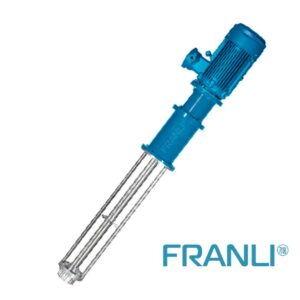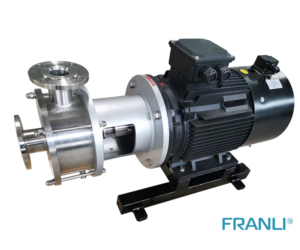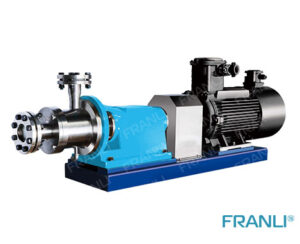Inline Emulsifier: Enhancing Emulsification Processes
Inline Emulsifier
Inline emulsifiers, also known as inline homogenizers or inline mixers, are powerful devices designed to perform high shear mixing, emulsification, dispersion, and particle size reduction in continuous flow. Unlike traditional batch emulsification methods, inline emulsifiers offer several advantages, including higher productivity, improved quality control, reduced energy consumption, and simplified process designs.
Details of Inline Emulsifier
- Suitable for the material before the process
- Small energy consumption
- Large capacity
- Certain self-suction and low lift transport function
Application: Paint, Adhesive, Battery, Pharmaceutical industry, Cosmetic
The emulsification process is an integral part of various industries such as food and beverages, pharmaceuticals, cosmetics, and chemicals. It plays a crucial role in creating stable and smooth emulsions, where two immiscible liquids are dispersed into each other. One of the major advancements in emulsification technology is the inline emulsifier. Combining efficiency, versatility, and cost-effectiveness, inline emulsifiers have revolutionized the emulsification process.
Working Principle of Inline Emulsifiers
Inline emulsifiers operate on the principle of high shear mixing. The emulsion ingredients, such as oil and water, are continuously pumped into the emulsifier, where they pass through a rotor-stator system. The rotor consists of a high-speed rotating component with teeth, while the stator has slots or perforations. As the product enters the rotor-stator assembly, it experiences intense turbulence, resulting in high shear forces that break down the droplets into smaller sizes. This process ensures thorough mixing and uniform distribution of the dispersed phase within the continuous phase, creating a stable emulsion.
Benefits of Inline Emulsifiers
1. Increased Productivity: Inline emulsifiers enable continuous production, eliminating the need for batch processing. This drastically reduces downtime and enhances overall productivity, making them ideal for high-volume manufacturing.
2. Improved Quality Control: Inline emulsifiers offer precise control over emulsion characteristics, such as droplet size, particle size distribution, viscosity, and stability. This enhanced control ensures consistent product quality and helps in meeting regulatory requirements.
3. Energy Efficiency: Inline emulsifiers minimize energy consumption by utilizing high shear forces to shorten processing times. They eliminate the need for additional heating or cooling equipment, saving energy costs.
4. Scalability: Inline emulsifiers are available in various sizes and configurations to suit different production capacities. They can seamlessly integrate into existing production lines or be custom-designed for specific applications, allowing for easy scalability.
Applications of Inline Emulsifiers
1. Food and Beverages: Inline emulsifiers find extensive use in the food and beverage industry, where emulsions, such as mayonnaise, sauces, dressings, and dairy products, are produced at high volumes. They ensure consistent texture, stability, and flavor in these products.
2. Pharmaceuticals: Inline emulsifiers play a crucial role in pharmaceutical manufacturing processes, where controlled and uniform emulsions are required for drug formulations, creams, ointments, and parenteral products.
3. Cosmetics and Personal Care: Inline emulsifiers are widely used in the cosmetics and personal care industry for the production of creams, lotions, gels, and emulsified serums. They ensure smooth texture, enhanced stability, and easy absorption of these products.
4. Chemical Industry: Inline emulsifiers find applications in the production of paints, coatings, adhesives, and various chemical formulations. They facilitate the dispersion of pigments, polymers, and additives, ensuring homogeneity and stability.
Inline emulsifiers have transformed the emulsification process by offering increased productivity, improved quality control, energy efficiency, and scalability. With their ability to create stable and uniform emulsions in a continuous flow, inline emulsifiers have become an essential tool in various industries. Whether it’s food manufacturing, pharmaceuticals, cosmetics, or chemicals, the benefits of inline emulsifiers make them a valuable asset for companies seeking to enhance their emulsion production processes.
Welcome to send inquiry to us and let’s make a win win business together !
Guidelines For High Shear Mixer
The mixing device of the high shear mixer is a rotor with four blades, which rotates at a high speed in a stationary stator to complete the entire stirring and mixing process.

High Shear Mixers: A Guide to Applications in the Cosmetics Industry
A high shear mixer is one of the most versatile pieces of equipment used in the cosmetic industry. It is designed to mix, emulsify, disperse, and homogenize a wide range of cosmetic products.

What is a High Shear Emulsifier?
High shear emulsifiers are innovative and efficient machines that are used in various industries for the purpose of emulsification, homogenization, and particle size reduction.

What is an Inline Homogenizer?
An inline homogenizer is a machine that is used to mix and blend different substances together to create a uniform mixture. It is an essential tool in the manufacturing industry, particularly in the production of food, pharmaceuticals, and cosmetics.

What is an Inline Emulsifier?
An inline emulsifier is a type of high shear mixer that is designed to create a stable emulsion by breaking down the droplets of one liquid into smaller droplets and dispersing them throughout the other liquid.

High Shear Mixer: An Essential Tool for Efficient Mixing
A high shear mixer is a device that is used to mix, emulsify, disperse, and homogenize materials. It is a versatile tool that can be used in a variety of industries such as food, pharmaceuticals, cosmetics, and chemical manufacturing.

High Shear Mixers: Experimental & Production
High-shear mixers are primarily used in industry to produce standard mixtures of ingredients that do not mix naturally. When the total fluid of the material is composed of two or more liquids, after the work of the high-shear mixer, an emulsion is finally formed.

